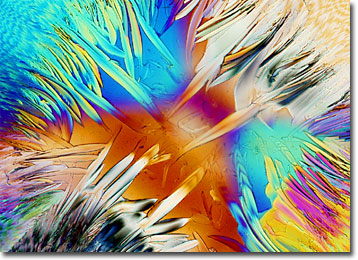Polarized Light Microscopy Digital Image Gallery
Vitamin C
Vitamin C is a water-soluble vitamin that humans are unable to manufacture in the body, although several other animals and plants are able to do so. Thus, humans must acquire the important vitamin through dietary sources.

Within the human body, vitamin C is involved in a number of key activities. One of the most important of these activities is assisting in the production of collagen, the primary protein utilized to synthesize connective tissue, which is necessary for proper bone, skin, and cartilage formation. Vitamin C, which is also known as ascorbic acid, is a critical antioxidant and free radical scavenger as well, though its effectiveness as an antiviral agent is debatable. Due to the importance of its functions, vitamin C intake is necessary for humans on a regular basis since it quickly passes through the body. Among the numerous sources of the vitamin are citrus fruits, tomatoes, peppers, melons, broccoli, and green leafy vegetables.
A condition known as scurvy is caused by a deficiency of Vitamin C. Though the origin of this condition was unknown for many years, a description of the symptoms with which it is associated appears in one of the oldest known medical texts, the Ebers Papyrus of ancient Egypt. These symptoms include slow healing from wounds, a loosening of the teeth, swollen gums, and bruises or open sores on the skin. In 1747, James Lind, a naval surgeon, discovered that citrus fruit and their juices provided relief from the disease. Subsequently, British military seaman, who often spent extended periods of time away from land consuming nonperishable foods with little vitamin content, were provided with a daily ration of lime juice to stave off outbreaks of scurvy.
